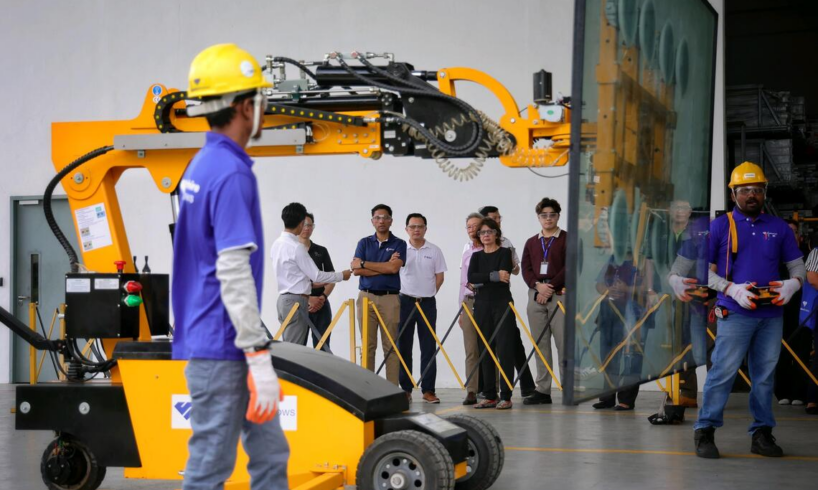
SINGAPORE – A factory in Loyang uses machines to cut, package and carry massive panes of glass, some weighing as much as 250kg each.
Their introduction has eliminated the need for workers at window supplier Sapphire Windows to carry the glass, previously a four- to 10-man task, depending on the weight of the glass.
The local company introduced these robots around 2022. The robots are used in the factory and at sites where the panes of glass are installed.
One type of machine, known as a glass-lifting robot, has several round discs that use suction to attach to huge pieces of glass.
This automation has improved what used to be a manual job, said the company’s general manager, Mr Sean Liew.
He also hopes that the use of robots to lift heavy panes of glass will help prevent musculoskeletal disorders, a type of occupational disease, in the company’s workers.
“We used to have more people than machines. Now, we have more machines than people,” Mr Liew said on Sept 30, during Minister of State for Manpower Dinesh Vasu Dash’s visit to Sapphire Windows.
One type of machine, known as a glass lifting robot, has several round discs that use suction to attach to huge pieces of glass.
ST PHOTO: KEVIN LIM
On the same day, the Manpower Ministry released its
workplace safety and health report for the first half of 2025
.
The construction and manufacturing sectors contributed to 43 per cent of the major injuries reported during that period.
The manufacturing sector, to which Sapphire Windows belongs, accounted for 55 major injuries and no deaths in the first half of 2025, compared with 63 major injuries and two deaths in the first half of 2024.
Within manufacturing, the number of fatal and major injuries from metalworking – the process of shaping items out of metal – dropped from 24 to 17 between the first half of 2024 and the same period in 2025.
Sapphire Windows, which is in the metalworking industry, reported three injuries between 2014 and 2019.
In one case, a worker reported a strained back from carrying the glass panes, Mr Liew said. Another time, a worker who was not wearing gloves suffered a cut on his arm. In the third instance, a piece of metal fell off a trolley and hit a worker’s hand.
Mr Liew said the last injury was reported in 2019, and that the company has not had any injuries since then.
“We empower the workers to (decide to) stop work if they see something unsafe, report a colleague if they see something unsafe. We also try and remind them that it is worse to hide it (than) report it,” said Mr Liew, who also noted that workers are often deployed to construction sites and at height to install windows, which are heavy.
His company also requires workers to use ear plugs in certain areas of the factory, and to don gloves when handling glass.
There were 465 cases of occupational diseases between January and June, MOM said, slightly lower than the 468 cases in the same period in 2024, but higher than the 431 in the second half of that year.
Sixty per cent were noise-induced deafness, followed by work-related musculoskeletal disorders at 26 per cent.
Workers packaging glass in the factory of Sapphire Windows in Loyang Drive on Sept 30.
ST PHOTO: KEVIN LIM
Assistant foreman Jahid, who goes by one name, joined Sapphire Windows 15 years ago, long before he and his colleagues had robots to help them.
He said working with machines has made the work much safer, as workers no longer needed to carry heavy materials, whether on the factory floor or at work sites.
“It’s better than last time,” he said.
Workplace safety and healthAccidents – workplaceMinistry of ManpowerDinesh Vasu Dash





